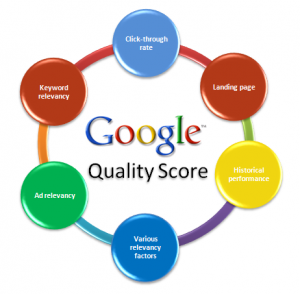
Your Google Adwords advertising Quality Score is a weighted average from 0 – 10 based on how relevant your ads, keywords, and landing page are to a person searching and engaging with your ad. The reality is that having a high Quality Score can lead to lower prices and better ad positions. Quality scores are measured per keyword and can be found in your Adwords campaign under keywords and displaying the column.
The Quality Score of each keyword is calculated every time your keyword matches a search. The more relevant your ads and landing pages are to the person searching, the higher your Quality Score. Your keyword scores will affect your ad position on the page as well as your prices.
Factors Determining Keyword Quality Score:
- Your expected click-through rate (CTR).
- The ad relevance of each keyword as it relates to the Ad Groups.
- The ad relevance as it relates to your text copy.
- Landing page where people are sent when they click on your ad. The quality, relevance and page experience.
- Your overall historical AdWords account performance.
The keyword scores is evaluated depending on what network your ad appears, meaning that you have a different Quality Score on Search vs. Display Network sites. The Quality Score for mobile devices is calculated slight differently as well.
How Quality Score Affect You Campaign
Your Google Adwords is directly affected by the keyword scores. Managing your keyword scores is important to insure your allocated budget reaches maximum potential.
- Higher Quality Scores make it easier and cheaper for a keyword to enter the ad auction. If your scores are low you may see a notice from Google indicating the ad is not being shown due to a low quality score.
- Higher Quality Scores lead to lower cost per click (CPC). This means you pay less per click and your existing budget can go farther.
- Higher Quality Scores lead to your ad to be shown on the first page of search results, especially with competitive keywords.
- Higher Quality Scores lead your ad to shown towards the top of the page. Although you may have a lower bid for the keyword, a higher quality score means you will be shown before advertisers with higher bids and lower keyword scores.
- Higher Quality Scores makes your ad campaign eligible for ad extensions and other ad formats. Some ad formats require a minimum Quality Score to be shown. Your ad position will determine whether or not your ad is eligible to be displayed with ad extensions and other ad formats.(To learn more about ad extensions, please see “Understanding Ad Extensions in Google AdWords“)
In a nutshell, higher keyword scores typically lead to lower costs and better ad positions. The AdWords system works best for everybody – advertisers, customers, publishers, and Google – when the ads we show are relevant, closely matching what customers are looking for. Relevant ads tend to earn more clicks, appear in a higher position, and bring you the most success.
Example Customer Looking For Brown Shoes
Let’s say that you own a website that specializes in shoes, and Joe, a customer, is looking for “brown shoes”. Wouldn’t it be great if Joe searched “brown shoes” in Google, saw your ad about “brown shoes”, clicked it, and landed on your webpage and bought “brown shoes”? This would fall into the category of the ideal user experience from end-to-end.
This is a situation where the customer searched for something specific, found what they wanted by clicking the relevant ad, and made a purchase. This will earn you a high Google Quality Score. The more relevant the ads to a search, the more likely they are to get more clicks, therefore appear in a higher position amongst the advertisers, and ultimately bring you the website owner the most success.
Where To Find Your Quality Score
There are two ways for you to check your quality score in the Adwords campaign starting with the Keywords tab.
- Option #1 Check The Speech Bubble
In the STATUS column of the Keywords tab, you can click the speech bubble to find the factors affecting your quality score. This bubble tends to be available when you have a Ad Disapproval in the status column or a notice indicating why a keyword is not being shown. - Option #2 Make The Quality Score Column Visible
In most cases Google does not automatically include the Quality Score column in your default view in the Keywords tab. To make the quality score visible you can:- Click the Columns drop-down menu
- Select Customize columns.
- Select Attributes.
- Click Add next to “Qual. score”.
- Click Save.
What To Do When You Manage Large Quantity Of Keywords
Managing a large volume of keywords in your ad campaign may not make it conducive to view the Quality Scores easily for all of them through your web browser or even easily isolate the lower scoring keywords.
Once the Quality Score column is visible in your the Keywords tab, you can download all statistics about your keywords into a spreadsheet file. The most popular about be in an Excel format.
To download an Excel format click on the download button, which is a small down arrow button under the main tabs.
A gray shaded box will appear on your screen giving you special options for your download. Assuming you do not need to make any special changes you can simply click on the blue download button.
What We’ve Learned
If your keywords have low quality scores then there is a significant disconnect amongst your ad groups, your ad text, your keywords and your landing page content. Relevance of your ads and landing page to the search term will greatly improve your scores, which is directly related to the Click Through Rate (CTR).
High quality scores will happen when all four of these segments are properly organized and help you achieve lower prices per click and better ad positions.
Reaching targeted customers with good quality scores in your local area can be achieved with hyperlocal advertising, which you can learn more about in our previous week’s editorial “Use Hyperlocal Advertising to Reach Nearby Consumers“.
Author: Melih Oztalay
























